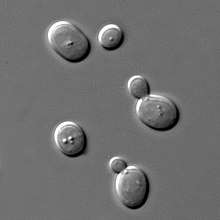Saccharomycetaceae
The Saccharomycetaceae are a family of yeasts in the order Saccharomycetales that reproduce by budding. Species in the family have a cosmopolitan distribution, and are present in a wide variety of habitats, especially those with a plentiful supply of carbohydrate sources.[1] The family contains the species Saccharomyces cerevisiae, perhaps the most economically important fungus.
| Saccharomycetaceae | |
|---|---|
 | |
| Saccharomyces cerevisiae under DIC microscopy | |
| Scientific classification | |
| Kingdom: | Fungi |
| Division: | Ascomycota |
| Class: | Saccharomycetes |
| Order: | Saccharomycetales |
| Family: | Saccharomycetaceae G.Winter (1881) |
| Type genus | |
| Saccharomyces Meyen ex E.C.Hansen (1883) | |
Genera
According to the 2007 Outline of Ascomycota, 20 genera are within the family, although for several of these (marked with a question mark below), the placement is uncertain and requires more study.[2]
Brettanomyces
Candida
?Citeromyces
?Cyniclomyces
?Debaryomyces
?Issatchenkia
Kazachstania (synonymous with Arxiozyma)
Kluyveromyces
Komagataella
Kuraishia
Lachancea
?Lodderomyces
Nakaseomyces
?Pachysolen
Pichia
Saccharomyces
Spathaspora
Tetrapisispora
Vanderwaltozyma
Torulaspora
?Williopsis
Zygosaccharomyces
Zygotorulaspora
References
- Cannon PF, Kirk PM (2007). Fungal Families of the World. Wallingford, UK: CAB International. pp. 320–21. ISBN 978-0-85199-827-5.
- Lumbsch TH, Huhndorf SM (December 2007). "Outline of Ascomycota – 2007". Myconet. Chicago, USA: The Field Museum, Department of Botany. 13: 1–58.